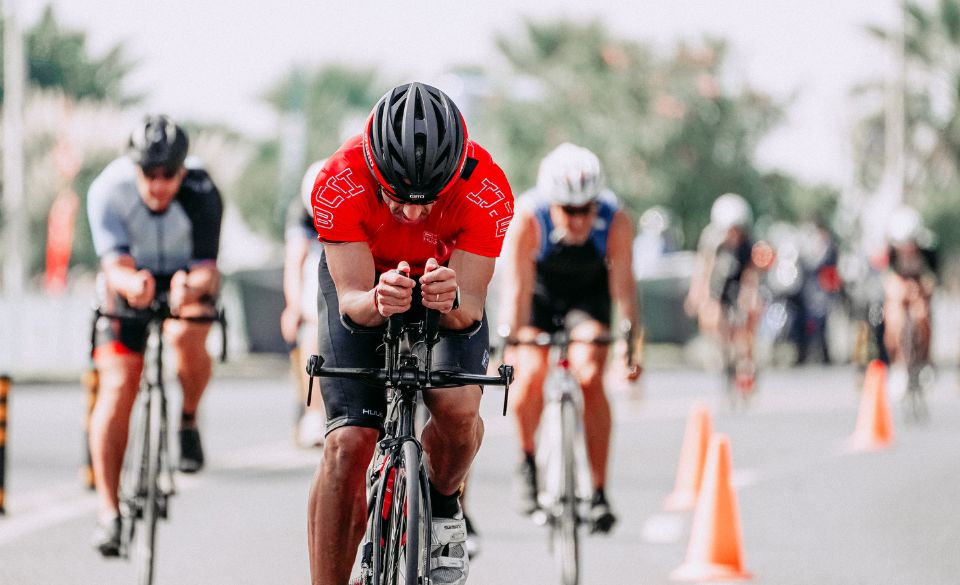
Triathlon Fueling Guide: Essential Тips
Page Contents
You can sometimes hear that the triathlon has four disciplines: swimming, biking, running, and nutrition. And if you’ve ever tried a workout that even remotely resembles a triathlon race, then you probably know how true that is – an athlete is only as good as his engine. That’s why fueling correctly is often the key to completing a triathlon and getting better results.
Typically, while training for a triathlon, you do your bike, swim, and run workouts separately. However, on race day, you’re required to put all three together without taking long breaks, which makes proper fueling even more important as you will want to avoid any performance or gastrointestinal issues. And then, you will want to focus on nutrition in order to recover from all that work you did.
In this article, we’re going to discuss just that – triathlon nutrition, how to fuel for race day, and the essential tips you need to know if you decide to dip your foot into this challenging discipline.
Triathlon Fueling Essentials
Similar to the marathon, triathlon fueling has several steps: before the race, during the race, and after it. And all three are key if you want to perform and recover to the best of your ability. That is why we’re going to talk about all three of those “stages” separately, and hopefully, by the end of this article, you will know how to prepare for each one of them.
Pre-Race Fueling
As race day approaches, increasing your carbohydrate and sodium intake is important. You should start adding extra calories to your dinners about five to seven days before your triathlon so that your body can adjust to the increased carbs and salt in your body. Along with that, you should aim to find a dinner that you enjoy but that doesn’t contain any possible irritants for your stomach.
Typically, it’s recommended to have something like fish and plain white rice without any fancy sauces or pasta with chicken and olive oil, as those meals are great nutritionally but don’t contain anything that could possibly cause you gastrointestinal issues on race day.
Now, if you really, really hate the idea of eating such plain meals, you can add things like salt and pepper, but it’s good to avoid any heavy sauces that contain cream or too many spices. And it’s especially vital to avoid any kind of exotic cuisine that you’ve never tried before.
Besides the dinner you have on pre-race night, the breakfast on race day is also a crucial part of triathlon nutrition. The key here is to remember – the fact that something is healthy doesn’t mean it’s good for triathlon fuel. Endurance races require two things – electrolytes and carbohydrates, something that is hardly found in an egg omelet (even though that’s a great breakfast option most days).
Many people claim that their race breakfast is eggs, bacon, and toast and that it never causes them any problems. But the key word here is “problem” – the fact that something doesn’t cause issues doesn’t necessarily mean that it helps your performance.
That’s why, when you’re having your first meal on race day, you should aim for something that’s high in carbohydrates, easy to digest, and that you can eat a lot of. More often than not, triathlon athletes love to have a bowl of oatmeal with honey and some fruit or with nut butter and fruit.
Having that kind of fuel before your race will ensure that you have enough energy throughout all of the events since carbs are the one thing that provides your muscles with the ability to last through strenuous efforts. And it will also minimize the risk of any digestion issues – something that can’t be guaranteed if you opt for eggs and bacon.
During the Race
Beginners often think that fueling for a race ends with breakfast. However, that’s not true at all. As we all know, triathlon consists of three separate endurance disciplines: swimming, biking, and running, and the longer the distance of each one is, the bigger the need for nutrition during the race.
Another common beginner mistake is drinking too much plain water. There’s a good reason why electrolyte powders and drinks exist – they’re terrific fuel that not only helps the athlete hydrate but also replenish the glycogen stores that get used up during long endurance races, and they also are key for getting the much-needed sodium that gets lost in the process of sweating.
Before the usage of electrolyte drinks spread, cases of hyponatremia or low sodium were quite common during marathons and triathlons, and they often led to athletes cramping heavily, fainting, and not being able to go ahead with the race. Most people don’t know this, but sodium is an essential electrolyte for our bodies, and it must be maintained at a certain amount. Typically, we’re able to have a great sodium balance, but when you add heavy sweating and little or no adequate hydration, the sodium in our bodies becomes diluted, and it can lead to fatigue, nausea, vomiting, drowsiness, cramps, seizures and in some severe cases it can even cause coma.
Thankfully, all of these gloomy scenarios can be easily avoided. Most races now have checkpoints for drinks and food, and you can also carry energy gels and drinks with you throughout the entire race, thanks to accessories such as backpacks and special side pockets created for triathletes.
Our recommendation is to have an energy gel and a sip of an electrolyte drink every 30/45 minutes, depending on how long your race is. Remember, you always want to be one step ahead; you don’t want to be fueling when you’re already feeling hunger or thirst – that is a sign you’ve missed your mark.
After the Race
It’s highly likely you won’t be doing back-to-back triathlons, but you will still want to have your body recover in the best way possible so that you can get to training as quickly as possible. In order for that to happen, you have to consider all your actions after the race is finished. First, it’s good to get both carbs and proteins as soon as you can – typically, athletes use some kind of recovery shake that can be easily absorbed and also helps with hydration. After that, it’s vital to have a high-quality meal rich in both proteins and carbs so that all those muscles that were torn during the race can start to recover. As you can probably guess, the meals that you eat during race day and in the day following will typically be higher in calories and more carbohydrate-dense. That’s normal, and it is what your body will need for optimal recovery.
The Distance is Important
The general rule of both marathons and triathlons is the following: the longer the race, the more important the nutrition. If you’re planning to do a triathlon that’s 1-mile swimming, 10 miles biking, and 3 miles running, then you can probably get away with eating and drinking as you normally would, but if you’re going for serious distances that truly challenge your body, then you have to prepare in the best possible way.
Under fueling or underhydrating as the distance increases or as the temperatures become hotter can cause significant performance issues. It can lead to cramps, fatigue, bloating, GI distress, inability to continue, and even fainting. And so it can turn out that not paying enough attention to your nutritional needs can lead to you being unable to finish a race or, even worse, you ending up needing medical attention.
The Things That You Should Remember
– Make sure always to have a race-fueling plan – one that you’ve followed before, and that’s worked well. It’s good to practice fueling your race day during your triathlon training – especially if you’re a beginner.
– Focus on your endurance racing needs- primarily carbs and sodium. Avoid putting anything release in your body that can get in the way or cause unnecessary stress on your system.
– Replace your water with a special electrolyte drink – one that’s rich in sodium and carbs, so that you can hydrate and get essential minerals simultaneously.
– The longer the distance, the more dialed in your nutrition you should be. If you expect to be racing for more than 3 hours, then you need to prepare for that with energy gels, proper drinks, and, of course, good pre-fuel meals that will allow you to perform at your best during those longer triathlons.
– If the weather is hot and you expect to sweat more, then you need to increase your fluid intake – otherwise, you risk cramping up.
Last but not least – prioritize your recovery. In order to be a great athlete in the long haul, you need to learn to give your body what it needs so that it can bounce back from the hard work that is a triathlon.
Hopefully, you found this article helpful, and by now, you’ve learned all that you wanted to about triathlon fueling. And remember – the triathlon has four disciplines: biking, swimming, running, and NUTRITION.



